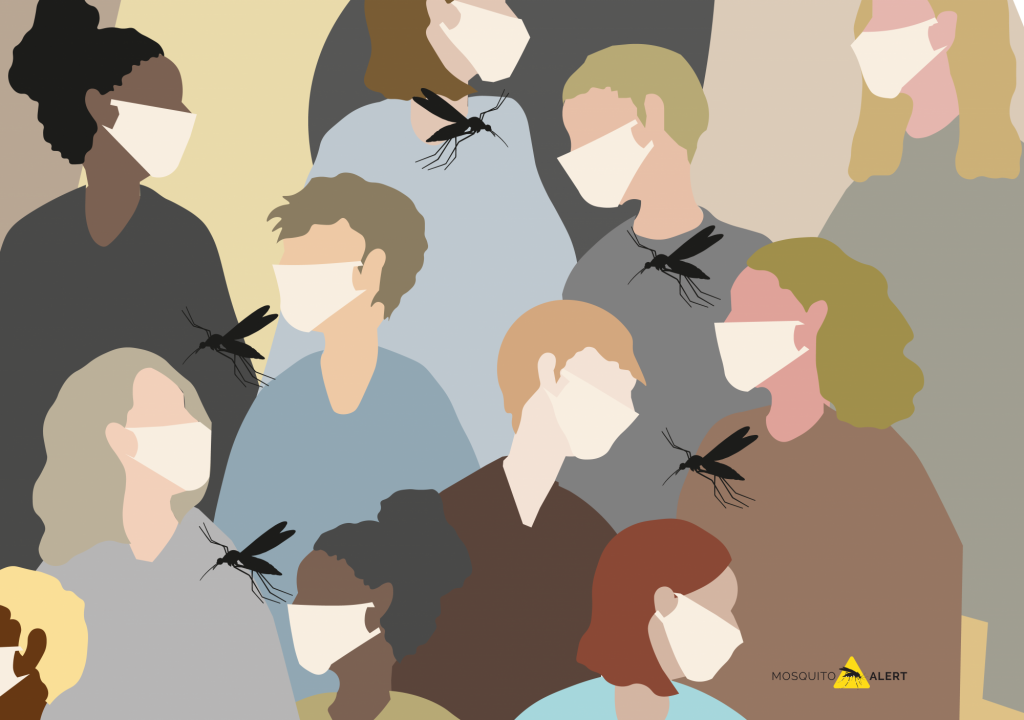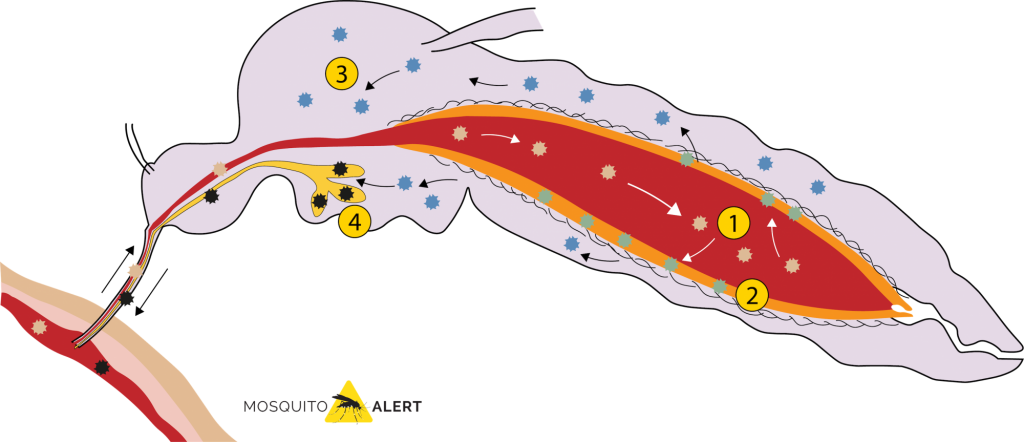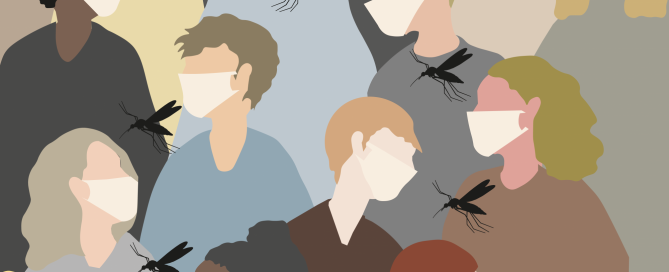The pandemic has paralyzed the world. With hundreds of thousands affected, Covid-19 has had a huge impact on the economy and has emptied public spaces across half the planet. The arrival of spring has found a large part of the population confined to their homes and with the cities practically empty. This time of year means that temperatures continue to rise and we have already had days of heavy rain. Conditions are ideal for mosquitoes to reactivate, and with its return, many people wonder if the tiger mosquito, or any other species of mosquito, can transmit the new virus.
Many people wonder if a mosquito can transmit SARS-CoV-2
The World Health Organization has made this clear: “to date, there is no information or evidence to indicate that COVID-19 can be transmitted by mosquitoes.” Furthermore, the WHO insists that “the new coronavirus is a respiratory virus that is spread mainly by contact with an infected person through the respiratory droplets that are generated when this person coughs or sneezes.”
If they transmit dengue, why not SARS-CoV-2, or the common cold?
The doubt is reasonable, because we know that some mosquitoes transmit viruses and other pathogens between people by biting them. If a tiger mosquito that bites a person infected with dengue can then transmit the virus to another person, can’t the same happen with the new SARS-CoV-2?
The same question arose in the late 1980s and early 1990s regarding HIV, until it was finally shown that the virus could not be transmitted by a mosquito. But HIV is not a rarity, viruses are the majority that cannot be transmitted by these insects. In fact, the rhinoviruses that cause the common cold belong to the Coronavirus family, and we will all agree that the cold is not transmitted by mosquitoes. Neither does the flu virus. Neither that of smallpox or Ebola.
It is common to think that if a mosquito has bitten a person infected with a virus, it can directly transmit the virus to its next victim. As if the mosquito was transfusing from one person to another, injecting the blood of its first victim into the next. But such a thing does not happen that way, because when a mosquito takes blood, it injects its saliva, but not the blood of its previous victim, who already digested days ago.

Fig. 1. Can a mosquito transmit COVID-19? There is no evidence of this, nor anything that suggests that this may be the case. Source: Mosquito Alert (CC-BY-NC-2.0)
The blood drawn by the sick person’s mosquito goes to their stomach, where digestion destroys viruses. This is the case, for example, with HIV, and with almost everyone else. For a virus to be transmitted by a mosquito, it must overcome a large number of barriers, which is not easy.
Arboviruses: viruses specialized in being transmitted by mosquitoes and ticks
The list of viruses that can be transmitted by mosquitoes may seem long, but it is very short when compared to the millions that cannot. Dengue virus (DENV), yellow fever virus (YFV), Zika virus (ZIKV), West Nile virus (WNV), Saint Louis encephalitis virus (SLEV), and chikingunya virus (CHIKV) stand out. ), the Ross River (RRV), Rift Valley fever (RVFV) among many other viruses. These mosquito-borne viruses are known as arboviruses, viruses carried by arthropods, mainly mosquitoes and ticks.
Viruses that can be transmitted by mosquitoes belong to a few families and are highly specialized. Not any virus can infect and be transmitted by a mosquito
Despite being enough, they represent a small proportion of the great diversity of viruses that exist. All arboviruses known to date belong to a few families of RNA viruses: Flaviviridae, Togaviridae, Bunyaviridae, Reoviridae, Rhabdoviridae, Orthomyxoviridae, and a single DNA virus from the Asfarviridae family. No virus in the Coronaviridae family, to which SARS-CoV-2 belongs, has ever been identified as an insect-borne virus.
The limited number of viruses that can be transmitted by mosquitoes is due to the ecological and evolutionary complexity that this implies from the point of view of the virus. It must not only be able to break through the immune system of a vertebrate organism (humans, for example), but also of the mosquito’s immune system.
Barriers that overcome arboviruses
In order to be transmitted by a mosquito, a virus must cross four main barriers. As it has already been said, the sucked blood, and the viruses that are in it, go to the mosquito’s digestive system (Fig. 2). The virus must survive in that hostile environment and be able to infect and replicate in the epithelial cells of the intestine. If you manage to overcome that barrier, then you still need to overcome the basal lamina that surrounds the intestine. Overcoming this second obstacle, the virus passes to the hemolymph and must be able to reach the salivary glands, which also pose a barrier to many viruses. Only if it can enter and replicate in the salivary glands can it be inoculated as soon as the mosquito bites another person. And it must replicate in large numbers because normally a few viruses are not enough.

Fig. 2. The route of infection of a mosquito by a virus, showing the main barriers that it must overcome in order to transmit itself through its bite. (1) Survive the digestive system and replicate. (2) Overcome the basal lamina that surrounds the intestine. (3) Tackle the mosquito’s antiviral immune response without killing it. (4) Reach the salivary glands and overcome their barrier. Image modified from the original by Rückert & Ebel 2018, Trends in Parasitology 34: 310-321. Source: Mosquito Alert (CC-BY-NC-2.0)
Regardless of all these barriers, the virus must face the mosquito’s antiviral immune response, but without making it sick. The mosquito should not suffer consequences because if the pathogen it carries were to kill it, it could not be transmitted and the virus would harm itself. Only specialized viruses are capable of making this journey through the mosquito without succumbing to any of its defensive barriers.
As we can see, arboviruses are a group of highly specialized viruses that throughout their evolutionary history of millions of years have developed an intimate association, both with a vertebrate host and with a mosquito in order to perpetuate themselves. So this only happens between a few mosquitoes and a few viruses.
To date, none of the coronaviruses, such as SARS-CoV-2, SARS, or MERS, have been classified as arboviruses capable of infecting a mosquito and transmitted through its bites. Therefore there is no reason to think that the tiger mosquito or the common mosquito can transmit SARS-CoV-2.
References:
Ciota AT, Kramer LD. 2010. Insights into Arbovirus evolution and adaptation from experimental studies. Viruses 2: 2594-2617
Coronavirus Study Group of the International Committee on Taxonomy of Viruses. 2020. The species Severe acute respiratory syndrome-related coronovirus: classifying 2019-nCoV and naming it SARS-CoV-2. Nature Microbiology 5: 536-544
Hanley KA, Weaver SC. 2008. Arbovirus Evolution. In: Origin and Evolution of Viruses. pp: 351-391
Iqbal MM. 1999. Can we get AIDS from mosquito bites? The Journal of the Louisiana State Medical Society 151: 429-433
Kuno G, Chang GJ. 2005. Biological transmission of Arboviruses: reexamination of the new insights into components, mechanisms, and unique traits as well as their evolutionary trends. Clinical Microbiology Reviews 2005: 608-637
Rückert C, Ebel GD. 2018. How do virus-mosquito interactions lead to viral emergence? Trends in Parasitology 34: 310-321
Wolf YI, Kazlauskas D, Iranzo J, Lucía-Sanz A, Kuhn JH, Krupovic M, Dolja VV, Koonin EV. 2018. Origins and evolution of the Global RNA Virome. American Society for Microbiology 9: e02329-18




